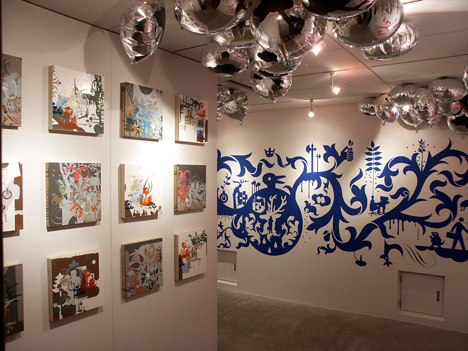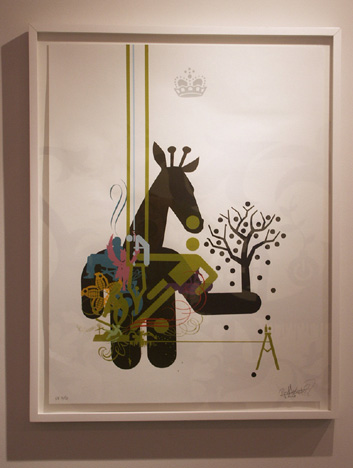RYAN MCGINNESS “THIS DREAM IS SO LIFE-LIKE”
HAPPENINGText: Taka Kawachi
From “Gasbook” to “Gas“. You might have already seen that this new label has already released many titles from talented creators through “Gas Book” and “Gas DVD”. “Gas Shop” opened in Nakamegoro, Tokyo with Gas.
The Ryan McGinness Exhibition has been at the gallery space on the first floor of the shop since the 18th of December, 2002 under the title of “This Dream Is So Life-Like”. A mural painting with Ryan’s trademarks, icons and signs, join paintings, silk screen works and his work from “Gas DVD” are on display.
Check out the interview with Ryan McGinness by Taka Kawachi, a curator of this exhibition.

This exhibition is titled “This Dream Is So Life-Like”. What kind of content is it like?
I’m interested in how dreams, surrealism, and the theater of the absurd relate to the real world around us. I’m also interested in an aesthetic that is rooted in the concrete: designs that serve to communicate clearly with an efficient use of form. These two interests are inherently at odds with each other as the former lends itself to more of a poetic and subjective interpretation of life and the latter strives to be as direct and objective as possible in describing life. “This Dream Is So Life-Like” assumes that what we know as reality has been flipped with what we consider the dream-world. I am declaring that this world around us is actually the dream, and I’m recognizing that it seems so much like the “real” world.
For your Deitch Projects show too, the title had the word Dream. Why?
The exhibition at Deitch was a collaboration with artist Julia Chiang. Our title was “Dream Garden,” because we wanted to create a garden environment that cultivated our dreams, and in materializing our desires, the dreams would come true. Imagine a world where all your dreams can come true if only you put in a little gardening effort into growing them. That really is the world we live in.

When you use signs and icons, or combine those for your work, do you always think of some stories or themes first?
No. I will usually pull together elements and allow the narrative to unfold. In doing so, I am allowing for the unconscious (and perhaps, by default, a collective unconscious) to come through in the work. The individual elements are carefully considered in their design and content, but a more free-form approach is taken when the juxtapositions are made. The associations within the work are often unconsciously made, and often people will interpret the work differently than I do. Of course, this is more than fine with me, and in fact, multiple interpretations are encouraged. I believe for me to state “this is what the work means…” is pompous and old-fashioned. We live in a multi-cultural and multi-perspective fluid world where all voices are equal. My goal is to create work that is just as fluid and amorphous in exact interpretation. However, I do hope to hint at universal themes that relate to everyone through the experience of simply being human. These themes emerge by allowing the unconscious or subconscious to contribute to the work.
You often do mural art for your show. What attracts you?
As my work develops, I find myself creating my own world-from letters to sounds to words to sentences to paragraphs to stories, narratives, myths, themes, and eventually an entire world. This is a world I want to share with other people and invite other people into. The murals and installations become environments that confront the viewer on a human scale that is inescapable and not as possible with singular wall pieces.
Read more ...





